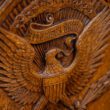Sign up here to receive The Yappie‘s weekly briefing on Asian American + Pacific Islander politics and support our work by making a donation.
Yellow Peril. The term has always been used in a hostile context. Yellow Peril, invading the U.S. and stealing white people's jobs. Yellow Peril, infecting Americans with their foreign and alien customs. Yellow Peril, hate-filled sneers in the streets.
But when Chris Kando Iijima, Nobuko JoAnne Miyamoto, and Charlie Chin founded their band in the 1970s, they decided to play on the term and name themselves Yellow Pearl. The move represented a claim on the Asian American identity, a shift from being defined by others to being defined by self.
Their music—a fusion of folk, blues, soul, and jazz—became a manifesto on Asian American power.
Iijima, Miyamoto, and Chin each grew up with a profound familiarity with racism. Iijima was born to activist parents—his father served with the famed 442nd Regimental Combat Team—and later became an active Vietnam War protester at Columbia University. Miyamoto's family was forcibly removed from their home and incarcerated in camps during World War II. Chin's parents worked low-wage jobs—his father in laundromats and Chinese restaurants, his mother in door-to-door sales and later as a lab technician—and Chin, one of the few Chinese kids in his New York City neighborhood, became a frequent target for racist bullies.
The trio came together after Miyamoto and Iijima met at a 1970 conference and sang together for the first time. The next day, they threw together a song for the Japanese American Citizens League.
“It was the first time I sang for an Asian American audience. For the first time, everybody realized we have our own song,” Miyamoto told Hyphen Magazine.
They decided early on that their music would be political in nature. “We had a job to do, and that job was to deliver a message: Inequality, racism, and sexism should be wiped out, and as Asians, we had helped build this country and had a right to be here,” Chin said in 2011.
Their 1973 album, “A Grain of Sand: Music for the Struggle by Asians in America,” captured the experiences of the first generation that identified with the term “Asian American.” The band sang of their lineage from immigrant workers and solidarity with freedom fighters, rising up again and again against marginalization.
We are the children of the migrant worker We are the offspring of the concentration camp Sons and daughters of the railroad builder Who leave their stamp on America We are the children of the Chinese waiter Born and raised in the laundry room We are the offspring of the Japanese gardener Who leave their stamp on America —Lyrics from Yellow Pearl's “We Are the Children”
The album was compiled in two days, mostly from first or second takes, while the songs were a gauntlet, challenging U.S. society to open their eyes and see. Their lyrics…
- Touched on social justice, both for Asian Americans and for all people of color.
- Spoke to the group’s close ties with the New York City Latino community.
- Sought to claim Asian Americas’ presence in history.
Their instrumentation was simple:
- 2 guitars
- 3 voices
- Sometimes backed by…
- Conga
- Bass
- Di zi
And then they took their music on the road.
“We became like griots, moving like troubadours from community to community—we’d say, ‘This is what is going on in New York … and we have this Chinatown health program going on,’ and we would carry this news to Sacramento and L.A. and Stockton and San Francisco. And then we’d gather stories from there and carry it back to New York. We were like the YouTube of the times—spreading the news,” Miyamoto told Smithsonian Folkways Magazine.
Their stages:
- Churches
- Colleges
- Community centers
- Coffeehouses
- Rallies
- Prisons
- Parks
- Buddhist temples


They also lent their voices to Black and Latino activist communities. Chin marched alongside Martin Luther King Jr. in the fight for civil rights, while Miyamoto produced a documentary on the Black Panthers. Later, at a Black nationalists event, Miyamoto befriended fellow Japanese American activist Yuri Kochiyama, confidante to Malcolm X who famously held him when he died.
The group stopped performing together after 1973, but they reunited to perform from time to time, their music a call back to those pivotal years.
Ijima later founded Asian Americans for Action, one of the first Asian American-focused civil rights groups, and became a law professor, writing about discrimination against Asian Americans, Native Hawaiians, and other people of color. In 2005, he died from a rare blood disease at age 57.
Miyamoto founded Great Leap, a Los Angeles-based Asian American arts organization, and continued to make music, producing concerts, musicals, music videos, and obon songs with other artists of color to engage communities across cultural borders.
Chin authored an adaptation of the Chinese folktale of Hua Mu Lan in 1993 and went on to collaborate with different organizations to educate people on the Chinese American experience through the Chinese Exclusion Act, Angel Island, World War II, and the civil rights movement, often through storytelling performances where Chin would adopt the persona of a Chinese immigrant.
The band may not be well known today, but their legacy remains.
When listening to Yellow Pearl, "[f]rom Boston to Chicago to San Francisco to Honolulu, Asian-derived people who had been classified in the Census as ’Other’ suddenly realized that they had an identity, a history, and a place at the table,” AsianWeek columnist Phil Tajitsu Nash wrote.









